 This past Saturday, members of EcoHusky attended the Yale Environmental Law Association’s conference, “New Directions in Environmental Law,” at Yale Law School in New Haven. A variety of speakers in the forms of panels, opening and keynote addresses, and discussions all united to display that the environment, sustainability, and climate change permeate a tremendous number of issues in law.
This past Saturday, members of EcoHusky attended the Yale Environmental Law Association’s conference, “New Directions in Environmental Law,” at Yale Law School in New Haven. A variety of speakers in the forms of panels, opening and keynote addresses, and discussions all united to display that the environment, sustainability, and climate change permeate a tremendous number of issues in law.
The day began with an opening address from environmentalist, author, and journalist, Bill McKibben, through a remote video call. An eloquent speaker, McKibben focused his message on using our passion, movement, and spirit as forms of currency to build countervailing power to the industries and big oil corporations ruling the world. He spoke of the necessary transition from education to confrontation, and how we cannot simply work at the margin; we must drive “core environmental change” through an active environmental movement. This, he said, will take everyone’s particular skill sets, as well as our willingness to be citizens of the globe.
Following was a panel on clean energy investing, presented by Judith Albert, Dr. Griffin Thompson, Andrew Darrell, and Daniel Winer. Each speaker provided a unique perspective on the necessity of collaboration to promote the use of clean energy. The government must work as a regulator to provide a positive role for businesses, investors must be connected with investment ideas they can be confident in, and green banks must work to leverage capital and offer long term, low cost financing for clean energy projects. There exist many barriers, as clean energy is still a new concept; however, successful communication between communities and the government can bridge that gap. The panel also spoke about the Supreme Court’s stay on the Clean Power Plan. While the recent news may have a “chilling effect” on investors, this does not diminish the long term impact of the plan.
 Later were four breakout sessions to choose from, with topics such as forest resiliency and the environmental impacts of violence in Colombia and Somalia. I chose to attend the session, “Coordinating Animal Law and Environmental Law,” hosted by Paul Waldau, Randall Abate, and Jonathan Lovvorn. About a third of global climate change is linked to agriculture and land clearing, and meat facilities account for a significant amount of water and land contamination; therefore, there is a clear connection between animal law and environmental law. Animal law currently does not have the leverage that environmental law has because the connection to human health gives environmental issues more federal coverage and legitimacy. Animal law does, however, appeal to humans’ abilities to care about other species, and triggers protection instincts, but there still exist too few federal laws regarding animal rights. What Waldau, Abate, and Lovvorn hoped to convey was that environmental and animal law have mutually valuable movements that could be much more powerful if they work collectively.
Later were four breakout sessions to choose from, with topics such as forest resiliency and the environmental impacts of violence in Colombia and Somalia. I chose to attend the session, “Coordinating Animal Law and Environmental Law,” hosted by Paul Waldau, Randall Abate, and Jonathan Lovvorn. About a third of global climate change is linked to agriculture and land clearing, and meat facilities account for a significant amount of water and land contamination; therefore, there is a clear connection between animal law and environmental law. Animal law currently does not have the leverage that environmental law has because the connection to human health gives environmental issues more federal coverage and legitimacy. Animal law does, however, appeal to humans’ abilities to care about other species, and triggers protection instincts, but there still exist too few federal laws regarding animal rights. What Waldau, Abate, and Lovvorn hoped to convey was that environmental and animal law have mutually valuable movements that could be much more powerful if they work collectively.
 After lunch, we heard from Christy Goldfuss, Managing Director at the White House Council on Environmental Quality. What stood out most in her keynote address was the importance of bridging gaps, whether it be between millennials and baby boomers, government and private businesses, or local citizens and the government. These connections are all vital in addressing major issues and developing solutions to climate change. A common theme throughout the conference was that the issue of climate change often breaks groups apart, and what we need to do is bring them back together.
After lunch, we heard from Christy Goldfuss, Managing Director at the White House Council on Environmental Quality. What stood out most in her keynote address was the importance of bridging gaps, whether it be between millennials and baby boomers, government and private businesses, or local citizens and the government. These connections are all vital in addressing major issues and developing solutions to climate change. A common theme throughout the conference was that the issue of climate change often breaks groups apart, and what we need to do is bring them back together.
Next was another collection of breakout sessions, including Indian water rights and workers’ rights and environmental harms. I chose to attend “Drinking Water at Risk: Flint and Beyond,” a discussion hosted by John Rumpler of Environment America and Khiara Bridges, a Professor of Law at Boston University. The crisis in Flint has acted as a window to a more serious issue, a concept they referred to as environmental racism. Residents in minority communities are disproportionately exposed to environmental hazards and toxins, including poor drinking water quality, proximity to fracking and factory farms, and susceptibility to the toxic chemicals from manufacturing. As Bridges stated, the lead and toxins are colorblind; governmental decisions and responses have shown racial inequality. Perhaps the best solution is to frame all of these environmental and human rights issues more broadly to encourage the interest convergence necessary for positive change.
Following was the panel, “Integrated Strategies for Climate Change,” comprised of Michael Gerrard, Kassie Siegel, Heather Whiteman, and Lemuel M. Srolovic. They spoke of the anticipated effects of current pledges and policies on global temperature based on greenhouse gas emissions, as well as feedback mechanisms and sensitive ecosystems. Whiteman focused on the impact of climate change on indigenous people and tribal water rights. She pointed out that tribal interests are often underrepresented in the Supreme Court; however, a notable accomplishment was the inclusion of indigenous rights in the COP21 agreement.
Lastly, Dr. Mark Mitchell, Founder and Senior Policy Advisor for the Connecticut Coalition for Environmental Justice, closed the conference with remarks that tied the entire experience together. Although there exists a disproportionate impact of certain environmental issues, we are all affected, and conferences like this one provide us with the dialogue and tools necessary to change the future.
-Christen
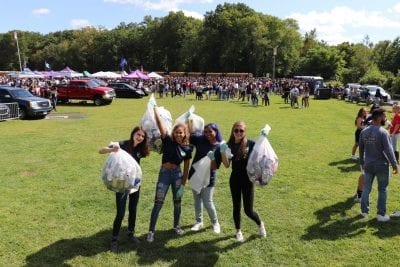
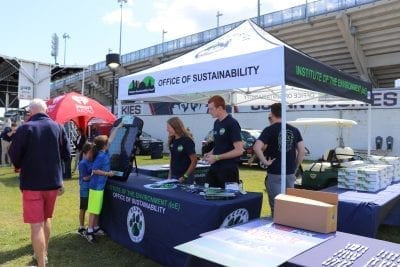
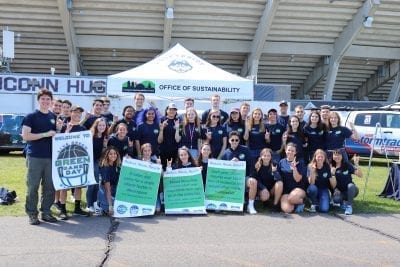



 Over 30 members of EcoHusky and the EcoHouse learning community got up bright and early on Saturday, October 8th, to volunteer at the Hartford Marathon in Bushnell Park. After a quick power nap on the bus, volunteers were ready for a day of excitement, positivity, and environmental awareness. Upon arrival at Bushnell Park in Hartford, volunteers mapped out the best locations for compost and heatsheet bins, as their primary responsibility for the day was to manage the waste stations throughout the park to ensure that runners and race-goers correctly disposed of food, recyclables, and foil blankets.
Over 30 members of EcoHusky and the EcoHouse learning community got up bright and early on Saturday, October 8th, to volunteer at the Hartford Marathon in Bushnell Park. After a quick power nap on the bus, volunteers were ready for a day of excitement, positivity, and environmental awareness. Upon arrival at Bushnell Park in Hartford, volunteers mapped out the best locations for compost and heatsheet bins, as their primary responsibility for the day was to manage the waste stations throughout the park to ensure that runners and race-goers correctly disposed of food, recyclables, and foil blankets.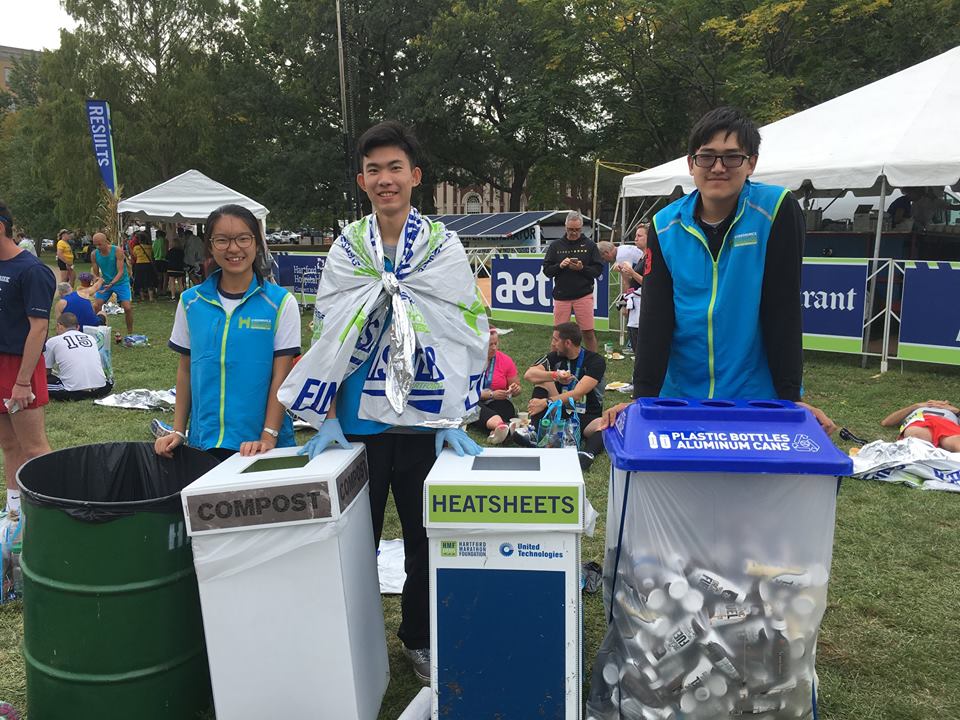 The Marathon’s efforts to reduce waste at the event are commendable; however, it was up to the volunteers from EcoHusky and EcoHouse to ensure that those efforts were seen through. Composting and recycling can have such positive waste diversion impacts, but only if the items are separated into the correct bins. Not only did volunteers ensure that this was done at the event, they also educated race-goers about recycling and composting so they could be more sustainable in their daily lives. Additionally, they tracked the bags of compost, weighing hundreds of pounds over the course of the day.
The Marathon’s efforts to reduce waste at the event are commendable; however, it was up to the volunteers from EcoHusky and EcoHouse to ensure that those efforts were seen through. Composting and recycling can have such positive waste diversion impacts, but only if the items are separated into the correct bins. Not only did volunteers ensure that this was done at the event, they also educated race-goers about recycling and composting so they could be more sustainable in their daily lives. Additionally, they tracked the bags of compost, weighing hundreds of pounds over the course of the day.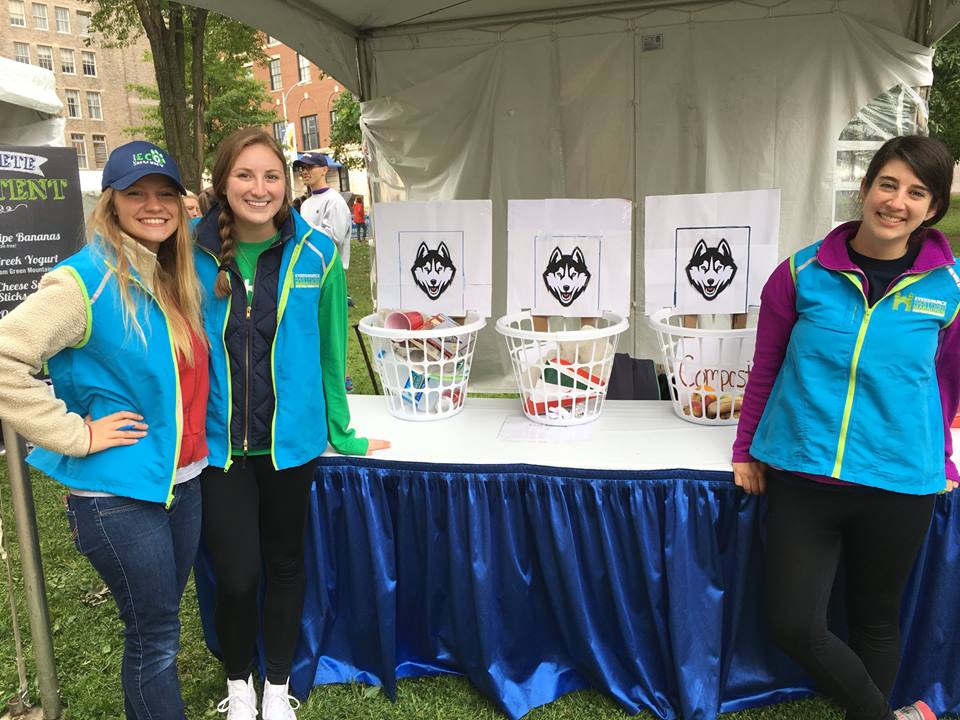 “Race-goers were attracted to the EcoHusky tent because of its peculiar set up – needless to say, no one else had a conglomeration of “waste” items and handmade basketball hoops scattered around their table. For such a simple and low budget idea, we still managed to make a big impact with the people we spoke to.” -Katie Main, EcoHusky Treasurer
“Race-goers were attracted to the EcoHusky tent because of its peculiar set up – needless to say, no one else had a conglomeration of “waste” items and handmade basketball hoops scattered around their table. For such a simple and low budget idea, we still managed to make a big impact with the people we spoke to.” -Katie Main, EcoHusky Treasurer This past Saturday, members of EcoHusky attended the Yale Environmental Law Association’s conference, “New Directions in Environmental Law,” at Yale Law School in New Haven. A variety of speakers in the forms of panels, opening and keynote addresses, and discussions all united to display that the environment, sustainability, and climate change permeate a tremendous number of issues in law.
This past Saturday, members of EcoHusky attended the Yale Environmental Law Association’s conference, “New Directions in Environmental Law,” at Yale Law School in New Haven. A variety of speakers in the forms of panels, opening and keynote addresses, and discussions all united to display that the environment, sustainability, and climate change permeate a tremendous number of issues in law. Later were four breakout sessions to choose from, with topics such as forest resiliency and the environmental impacts of violence in Colombia and Somalia. I chose to attend the session, “Coordinating Animal Law and Environmental Law,” hosted by Paul Waldau, Randall Abate, and Jonathan Lovvorn. About a third of global climate change is linked to agriculture and land clearing, and meat facilities account for a significant amount of water and land contamination; therefore, there is a clear connection between animal law and environmental law. Animal law currently does not have the leverage that environmental law has because the connection to human health gives environmental issues more federal coverage and legitimacy. Animal law does, however, appeal to humans’ abilities to care about other species, and triggers protection instincts, but there still exist too few federal laws regarding animal rights. What Waldau, Abate, and Lovvorn hoped to convey was that environmental and animal law have mutually valuable movements that could be much more powerful if they work collectively.
Later were four breakout sessions to choose from, with topics such as forest resiliency and the environmental impacts of violence in Colombia and Somalia. I chose to attend the session, “Coordinating Animal Law and Environmental Law,” hosted by Paul Waldau, Randall Abate, and Jonathan Lovvorn. About a third of global climate change is linked to agriculture and land clearing, and meat facilities account for a significant amount of water and land contamination; therefore, there is a clear connection between animal law and environmental law. Animal law currently does not have the leverage that environmental law has because the connection to human health gives environmental issues more federal coverage and legitimacy. Animal law does, however, appeal to humans’ abilities to care about other species, and triggers protection instincts, but there still exist too few federal laws regarding animal rights. What Waldau, Abate, and Lovvorn hoped to convey was that environmental and animal law have mutually valuable movements that could be much more powerful if they work collectively. After lunch, we heard from Christy Goldfuss, Managing Director at the White House Council on Environmental Quality. What stood out most in her keynote address was the importance of bridging gaps, whether it be between millennials and baby boomers, government and private businesses, or local citizens and the government. These connections are all vital in addressing major issues and developing solutions to climate change. A common theme throughout the conference was that the issue of climate change often breaks groups apart, and what we need to do is bring them back together.
After lunch, we heard from Christy Goldfuss, Managing Director at the White House Council on Environmental Quality. What stood out most in her keynote address was the importance of bridging gaps, whether it be between millennials and baby boomers, government and private businesses, or local citizens and the government. These connections are all vital in addressing major issues and developing solutions to climate change. A common theme throughout the conference was that the issue of climate change often breaks groups apart, and what we need to do is bring them back together.

